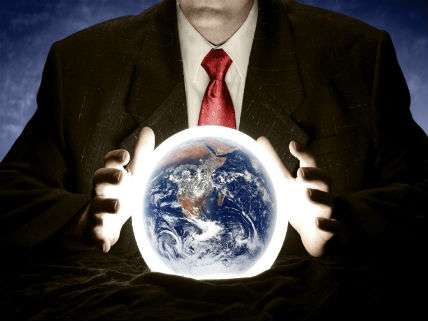A U.S. Department of the Future Is a Really Bad Idea
Unfortunately, there is no shortage of would-be Secretaries of the Future.

"I'll tell you…one thing that no Cabinet has ever had is a Secretary of the Future, and there are no plans at all for my grandchildren and my great grandchildren," the novelist Kurt Vonnegut groused in 2005. Vonnegut's comment came up on the public radio show Marketplace this month, when the program asked, "What if we had a Secretary of the Future?"
My quick answer: It's a really stupid idea. Human beings are terrible at foresight, and it would be especially terrible to try marry our purblind premonitions to government power.
Vonnegut was far from alone in pining for some sort of far-seeing federal planner. For the past half century, the chief motive for establishing planning bureaucracies has been an allegedly impending ecological and economic castastrophe. For example, in the 1968 book The Population Bomb, the Stanford biologist Paul Ehrlich proposed a new Bureau of Population and Environment. The tasks of this "powerful governmental agency," he wrote, would include determining "the optimum population size of the United States and devis[ing] measures to establish it." One such measure would be research on sex determination, so as to guarantee that first-born children were always male, thus satisfying the cultural demand for male heirs. Needless to say, male heirs by themselves don't produce male grand-heirs.
Ehrlich doubled down in Ark II: Social Response to Environmental Imperatives, a 1974 book that called for a Federal Planning Branch. Ehrlich and his co-author wanted to headquarter the new agency "not in the nations capital but in some relatively pleasant location that would induce talented young people to choose careers in public service." The planning board would, as Kirkus Reviews noted, be "composed of enlightened fellows" like Ehrlich. Its overall goal: to "curb individual appetites" and persuade the population to adopt "the lost tribalism of preindustrial society."
Two years later, in The Genesis Strategy: Climate and Global Survival, climatologist Stephen Schneider endorsed the creation of a "Truth and Consequences Branch," a fourth branch of government whose members would be appointed for 20 year terms. The Truth and Consequences Branch would work with the Institute of Imminent Disasters, founded to "assess the probable costs of avoiding any and all perceived disasters impending." The fourth branch would also engage in propaganda, pushing the public to "question present value systems and adopt a new political consciousness. Such a consciousness would move us away from narrow and immediate economic-interest policies and redirect our efforts and resources toward the creation of a stable equilibrium world order."
The fraught 1970s were capped off with two ominous federal exercises in crystal-ball gazing: The Global 2000 Report to the President commissioned by President Jimmy Carter, and the National Academy of Sciences' Energy In Transition: 1985-2010.
In 1977, Carter directed the Council on Environmental Quality, the State Department, and 11 other federal agencies to analyze "probable changes in the world's population, natural resources, and environment through the end of the century." He added, "This study will serve as the foundation of our longer-term planning." The head of the study was one Gerald O. Barney, who insisted that the study could only establish a "useful and meaningful" planning foundation "if, to the fullest extent possible, the Study was performed by U.S. Government personnel using U.S. Government data, and U.S. Government Models."
So what did the Global 2000 Report prognosticate? Let me quote Newsweek's stark summary: "The time: the year 2000. The place: Earth, a desolate planet slowly dying of its own accumulating follies. Half the forests are gone; sand dunes spread where fertile farm lands once lay. Nearly 2 million species of plants, bird, insects and animals have vanished. Yet man is propagating so fast that his cities have grown as his nations of a century before. The bleak scenario is not science fiction, but a detailed look at the real world's future." That was just a slight journalistic gloss on the Report's own preface: "If present trends continue, the world in 2000 will be more crowded, more polluted, less stable ecologically, and more vulnerable to disruption than the world we live in now. Serious stresses involving population resources, and environment are clearly visible ahead."

Global 2000 projected that world population would be 6.35 billion in 2000 and 10 billion by 2030. In fact, it was 6.1 billion (not too bad) in 2000 and is now projected to be 8.2 billion in 2030. By the way, the U.S. was projected to have 248 million people by 2000; instead we hit 282 million. The Report's projections that world gross product would increase by 145 percent and global per capita income would increase 53 percent were also fairly accurate.
Yet the percent of people living in extreme poverty—defined at a per capita income of less than $1.90 per day—has not increased but dropped, from 52 percent in 1980 to less than 10 percent today. The report also predicted that real food prices in 2000 would be 95 percent higher than they were in 1970. In fact, according the Food and Agriculture Organization, world food prices were almost 40 percent lower.
The forecasters' energy production projections were also wide of the mark. "Engineering and geological considerations suggest that world petroleum production will peak before the end of the century," the report declared. "A world transition away from petroleum dependence must take place, but there is still much uncertainty as to how this transition will occur." Americans were expected to increase their per capita energy use from 286 million British Thermal Units (BTUs) in 1980 to 422 million BTUs in 2000. Using updated figures from the Energy Information Administration, Americans were instead using essentially the same amount of energy per capita in 2000 as they were in 1980, about 345 million BTUs. By 2011—the latest figures available—energy use in the U.S. had fallen to 313 million BTUs per capita. The report's medium scenario projected that in 1995 (the models didn't go further) the price of oil would be around $95 per barrel (in 1979 dollars); instead the inflation-adjusted figure averaged around $8 per barrel.
The report made yet more alarming assertions. By 2000, it said, "40 percent of the forests still remaining in the [less developed countries] in 1978 will have been razed." Since forest measurement techniques change frequently, it's hard to get a consistent trend on deforestation rates. But using worst-case data from a 2008 review article on forest trends in 90 tropical countries, tropical forest cover declined by 10 percent between 1980 and 2000. The Food and Agriculture Organization has noted that the global deforestation rate greatly decelerated since 1990 and may soon reverse.
And contrary to the report's prophecies, 2 million species did not go extinct between 1980 and 2000.
In 1980, the National Academy of Sciences' Energy In Transition: 1985 to 2010 more modestly tried to estimate how much and what type of energy Americans would be using over the next 25 years. In the middle of the road scenario in the 1980 NAS report, Americans would be using 150 quads of energy by 2010. (A quad is a quadrillion BTUs—the amount of energy in 45 million tons of coal, or a trillion cubic feet of natural gas, or 170 million barrels of crude oil.) The analysts projected that energy consumption in 2010 would be divvied up between 16 quads of crude oil, 14 quads of natural gas, 8 quads of synthetic liquid fuels from coal, 5 quads of synthetic gas from coal, a total of 50 quads of energy from coal, 41 quads from nuclear, 5 quads from hydropower, and nearly 11 quads from solar energy.
What actually happened? Americans in 2010 were using about 96 quads, split between 27 quads of crude oil, 22 quads of natural gas, 22 quads of coal, 8 quads of nuclear, 2.5 quads of hydropower, 10 quads of other liquid fuels such as natural gas condensates and ethanol, 3 quads of biomass, and 1.5 quads of renewable fuels like wind and solar. In other words, the middle-of-the-road scenario was off by 50 percent. U.S. energy consumption in 2012 (the latest figures we have) was also still around 96 quads.
What if U.S. government had heeded Ehrlich's warnings about overpopulation and impending famine? For an inkling of how this might have played out, check out Ehrlich's 1978 update of The Population Bomb, which praised China's incipient one-child population control program as "remarkably successful." Earlier, he had wistfully speculated about putting sterilents in the water supply, the effects of which could be reversed only by an antidote that officials would dole out to the deserving.
Or consider the Carter administration's energy policies, which were based on prognostications that the world was about to run out of oil. As countermeasure to the "energy crisis," Carter announced that he wanted 20 percent of America's energy to come from solar energy by 2000, costing a predicted $3 trillion—$8.6 trillion in 2016 dollars. In 1980, at Carter's behest, Congress created the Synfuels Corporation, endowing it with $20 billion with the goal of eventually building as many as 22 enormous coal gasification plants, each producing 300 million cubic feet of synthetic natural gas per day. That's enough to supply the daily needs of about 800,000 households. Only one half-scale pilot plant was ever built. It cost $2.1 billion ($6 billion today) and was later sold to a local utility for 4 cents on the dollar.
Had the Synfuels Corporation built all 22 of the coal gasification plants, their carbon dioxide emissions would have amounted 264 million tons per year. That would have boosted U.S. emissions of that greenhouse gas by 5 percent over current emissions. In other words, energy planners in the 1970s would have made the global warming problem worse for climate planners in the 2010s.
Why rehash these predictive failures? Clearly, people are always trying to discern the future so as make good decisions in the here-and-now. Private companies invest a good bit in trying to figure out future economic, social, and technological trends. Surely there's nothing innately wrong with that.
But if a private company gets its forecasts wrong, the worst that happens is that it goes out of business and is replaced by competitors who made the right calls. Markets are superb at marshaling vast quantities of information, and they amply reward foresight and good guesses.
The problem with government planning is government power. A Secretary of the Future would use dubious models to issue orders on how many children citizens may have or how much energy they may use. Given ineluctable human fallibility, the best thing we can do is to let our children and grandchildren make their own plans for the future.


Show Comments (133)